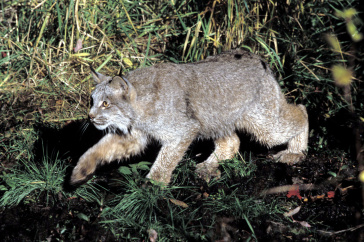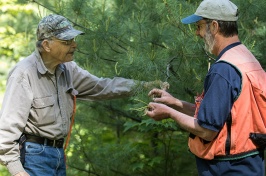The University of New Hampshire is a flagship research university that inspires innovation and transforms lives in our state, nation and world. More than 16,000 students from all 50 states and 71 countries engage with an award-winning faculty in top ranked programs in business, engineering, law, health and human services, liberal arts and the sciences across more than 200 programs of study. UNH’s research portfolio includes partnerships with NASA, NOAA, NSF and NIH, receiving more than $100 million in competitive external funding every year to further explore and define the frontiers of land, sea and space.
N.H. Veterinary Diagnostic Lab Scientists Discover Previously Unknown Parasite, Virus in Canada Lynx

A Canada Lynx in the forest. Credit: Erwin and Peggy Bauer/U.S. Fish and Wildlife Service.
DURHAM, N.H. – Scientists with the New Hampshire Veterinary Diagnostic Laboratory at the University of New Hampshire have discovered a previously undiagnosed parasite and virus in the Canada lynx. The parasite is transmitted by ticks and is known to infect domestic dogs. The virus is similar to the Epstein-Barr virus that causes mononucleosis in humans and is related to a virus that infects domestic cats.
The surprising findings were uncovered during a collaborative research study to establish a baseline of diseases affecting a seemingly healthy wildlife population, the Canada lynx. By obtaining this information, scientists should be better able to recognize an emergence of new diseases in the wild population and monitor the state of these natural diseases within lynx populations over time.
“Lynx in New Hampshire and Maine are on the southern edge of their natural range and are among the largest and most majestic predators in these states,” said David Needle, senior veterinary pathologist with the New Hampshire Veterinary Diagnostic Laboratory and assistant clinical professor at UNH. “The health of these apex predators can function as an indicator of the health of their varied prey species, and health of their wild environments.” Needle and Brian Stevens, also a senior veterinary pathologist and assistant clinical professor, are leading the project.
Canada lynx have been federally listed as threatened since 2000, and the only state in the Northeast with a resident breeding population is Maine. Recently, lynx have been observed in New Hampshire and Vermont, including female lynx with kittens, which suggests an expansion of their current habitat range.
Scientists performed postmortem examinations on 38 Canada lynx from the state of Maine Department of Inland Fisheries and Wildlife that were collected over 10 years after having been found dead, with the most common cause of death being hit by a car.
Scientists found lungworm infection in 22 of 32 animals where the lung was examined. According to Stevens, it is unclear how much of an affect the presence of these parasites had on the health of the lynx. Many cases had minimal reaction associated with the infection so the parasites were likely incidental. However, other cases had more severe inflammation associated with the parasites, which may suggest some effect on the overall health of these lynx.
Inflammation was also found in the heart and skeletal muscle of multiple animals, and in two animals noted a microscopic protozoal organism suggestive of Hepatazoon sp. Additional diagnostic tests are being performed to definitively identify the protozoal species in these lynxes. Protozoa are unicellular organisms, which occasionally lead to parasitic disease in different animal species.
“To our knowledge, the parasite we believe this to be has not been diagnosed this far north as it tends to infect animals in the southern states and has not been diagnosed in Canada lynx, although it is often diagnosed in bobcats in southern states. This parasite is transmitted by tick vectors and to this point, the range of these tick vectors is not described to be in Maine so it is unclear if the tick range has expanded into Maine or if the Hepatazoon-like organism in these lynx is one not normally found in North America,” Stevens said.
In collaboration with investigators at Western University in London, Ontario, Stevens and Needle also discovered a previously unknown virus in a subset of animals. This virus is similar to a gamma herpes virus recently identified in domestic cats, and is in the same family as Epstein-Barr virus, which causes mononucleosis and other diseases in humans. Stevens said it is unclear whether the virus is a causative agent of the disease in lynx.
“We are identifying infectious agents of importance to the wild lynx population, which could have impact throughout their range, and could impact other wild animals, and potentially domesticated animals. The finding of Hepatozoon-like organism was a surprise, as it has not been described previously this far north, or in this species. Hepatozoon is a known parasite of domestic dogs and is rarely a cause of disease in this geographic region, but if it is endemic in wild carnivores, then it may only be a matter of time before veterinarians start to seeing it affecting our own dogs,” Stevens said.
Stevens will present the initial findings of this study at the 74th Northeast Fish and Wildlife Conference in Burlington, Vermont, April 17, 2018.
This project was funded by the Maine Department of Inland Fisheries and Wildlife and supported by the New Hampshire Agricultural Experiment Station and the State of New Hampshire. Researchers worked with Jennifer Vashon of the Maine Department of Inland Fisheries and Wildlife who provided the samples of Canada lynx. Additional collaborators include Michael Yabsley with the University of Georgia, Jamie Strickland with Michigan State University, and Ryan Troyer with the University of Western Ontario.
The New Hampshire Veterinary Diagnostic Lab is co-managed by the New Hampshire Department of Agriculture, Markets & Food and the New Hampshire Agricultural Experiment Station. Since 1970, the lab has provided accessible, timely and accurate diagnostic services for the state’s Department of Agriculture, Markets, & Food, Department of Health and Human Services, New Hampshire Fish and Game Department, state and local law enforcement agencies, veterinarians, farmers, state, regional, and federal agencies, and individuals.
Founded in 1887, the New Hampshire Agricultural Experiment Station at the UNH College of Life Sciences and Agriculture is UNH’s original research center and an elemental component of New Hampshire's land-grant university heritage and mission.
EDITORS AND REPORTERS: Brian Stevens can be reached at brian.stevens@unh.edu. David Needle can be reached at david.needle@unh.edu.
Latest News
-
June 25, 2025
-
June 16, 2025
-
June 6, 2025
-
May 15, 2025
-
May 14, 2025















































